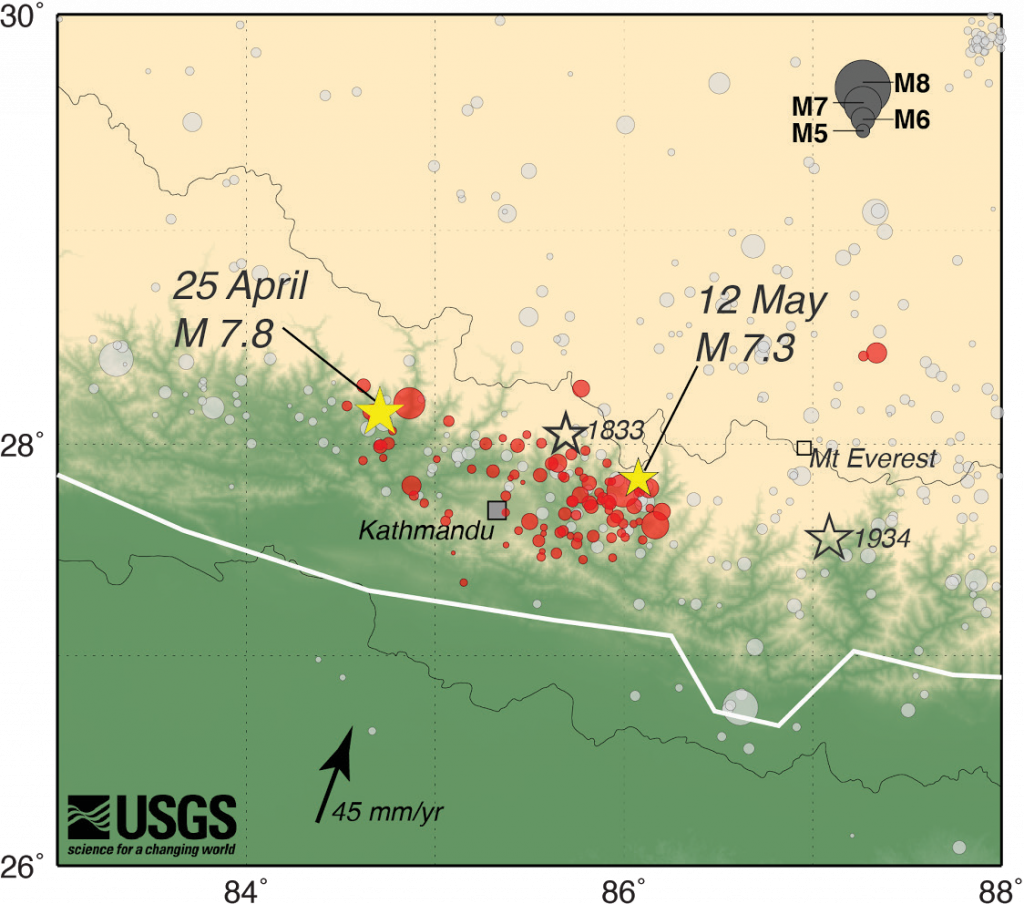Chapter 9. Earthquakes
Adapted by Sean W. Lacey & Joyce M. McBeth (2018) University of Saskatchewan from Deline B, Harris R, & Tefend K. (2015) “Laboratory Manual for Introductory Geology”. First Edition. Chapter 13 “Earthquakes” by Randa Harris, CC BY-SA 4.0. View Source. Last edited: 8 Jan 2020
9.1 INTRODUCTION
It was the deadliest day in the history of Mt Everest. On April 25, 2015, a 7.8 magnitude earthquake hit Nepal. This triggered an avalanche that killed 19 climbers on Mt Everest. In Nepal, over 8,800 people died, and many more were injured and made homeless. Hundreds of aftershocks (smaller earthquakes that follow a larger earthquake) have occurred since the initial earthquake (Figure 9.1). Earthquakes are not new to the region where Mt Everest resides. A similar death toll was experienced in a 1934 earthquake, and many other smaller earthquakes have occurred within historical times.

Source: Harris (2015), map originally from USGS Public Domain view source
An 1833 earthquake of similar magnitude in the same region resulted in less than 500 deaths. In this case, there were two very large foreshocks (smaller earthquakes that precede the main earthquake) that sent most residents out of doors in alarm. Fewer people were indoors for the main earthquake and were thus spared injury and death when the earthquake hit. Worldwide, there have been much deadlier and stronger earthquakes in this century. For example, in 2010 the earthquake that hit Haiti killed an estimated 316,000 people, and the 2004 Sumatra earthquake killed approximately 227,000 people. The deaths in these earthquakes were related to ground shaking and the other hazards that were created by the earthquake.
While earthquakes can be highly destructive, they can also give geologists valuable information about the Earth. They can tell us about the structures in the interior of the Earth, and about conditions at the Earth’s surface.
9.1.1 Learning Outcomes
After completing this chapter, you should be able to:
• Compare and contrast the different types of seismic waves generated by earthquakes
• Understand the different scales used to measure earthquakes
• Understand how different geologic materials behave during an earthquake, and how these differences can impact structures during an earthquake
• Explain how to locate an earthquake epicenter on a map
• Explore the relationship between the oil and gas exploration and seismicity
9.1.2 Key Terms
• Benioff Zone
• Body waves
• Epicenter
• Focus
• Induced seismicity
• Intensity
• Liquefaction
• Love waves
• Magnitude
• P Waves
• Rayleigh waves
• S Waves
• Seismogram
• Seismograph
• Seismology
• Surface waves
• Wadati Benioff Zone

